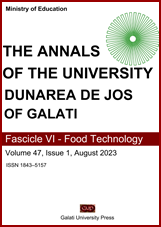Studies on white must clarification using enzyme preparations
Abstract
The use of pectolytic enzymes to clarify the white grape juice is a simple and economical solution for positively influencing the subsequent technological steps. The positive effects refer to improving the filterability of the final wine, the behavior of the wine during the stabilization treatments, and, most important, wine quality. The experimental study consisted of treating the grape juice with Zymoclaire Pro Ice for the maceration and extraction steps, and Zymoclaire CC Plus for the clarifying step. The evolution of grape juice clarification parameters such as turbidity, oxidation stability, and the dynamics of the alcoholic fermentation were monitored. The study revealed that after 24 h of treatment, a higher volume of clarified grape juice was achieved. The volume of clarified grape juice was 55% in the control samples, while in case of the sulfited grape juice, clarified with maceration and extraction enzymes or with clarification enzymes, reached 72% and 84%, respectively. The optimal turbidity levels of the juice’s enzymatic clarifying stage were reached after 24 hours in case of both enzyme treatments. The comparative analysis of the physicochemical parameters did not reveal significant differences between samples regarding free and total SO2 contents, potential alcoholic concentrations, volatile acidity, and residual sugars. Also, the enzymatically treated samples were the most appreciated from a sensory point of view. In conclusion, the results revealed that the enzyme tested in these experiments showed high efficiency in grape juice clarifying.


